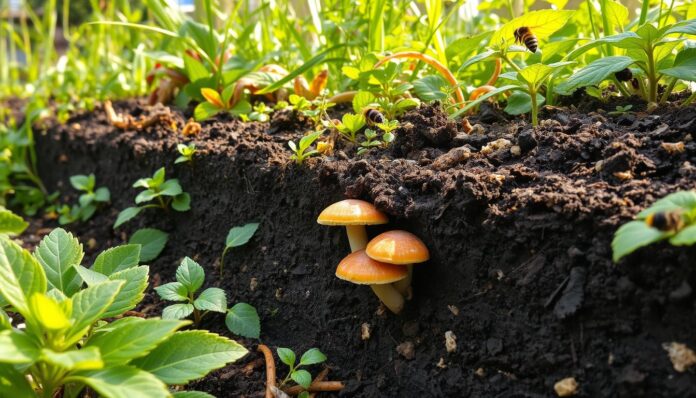What if mushrooms hold the secret to a greener future? With growing concerns about the environment, people want products that are kind to our planet. A study in the U.S. showed that mushroom farms could use less water and energy. It takes only 3.9 gallons of water to grow 2.2 pounds of mushrooms, much less than crops like tomatoes.
This makes us wonder: could mushrooms change the game for sustainable farming and soil health?
Key Takeaways
- Mushroom production requires significantly less water than other crops, with 3.9 gallons of water needed to produce 2.2 lb of mushrooms.
- The energy required to grow button mushrooms from substrate preparation to harvest is 1 kWh per 1 lb of mushrooms.
- Mycelium packaging provides a biodegradable alternative to traditional plastics, reducing reliance on non-renewable resources.
- Integrating mushrooms into permaculture practices promotes biodiversity and sustainable agriculture.
- Mushrooms are a nutritious addition to diets, low in calories and fat, and rich in essential minerals and vitamins.
- Mycelium can be cultivated to create protein-rich alternatives, addressing food production challenges for a growing global population.
Let’s dive into the world of sustainable mushroom production and packaging. We’ll see how mushrooms can help us achieve a greener future through permaculture and sustainable farming.
Introduction to Permaculture and Soil Health
Permaculture is a way of farming that focuses on creating ecosystems that are self-sustaining. It aims to increase biodiversity and improve soil health. This method is key to keeping soil healthy, as it supports regenerative farming practices and organic gardening techniques. By using permaculture, farmers can cut down on chemical use and make food production more sustainable.
Soil health is vital in permaculture. Healthy soils are crucial for plants to grow well. Permaculture uses many ways to build up soil, such as:
- Chop and Drop
- Lasagna Beds
- Hugelkultur
These methods help create ecosystems that need little outside help. By using regenerative farming practices and organic gardening techniques, farmers can make soil better, boost biodiversity, and support ecosystem services.
Studies show that permaculture can boost biodiversity by up to 40% compared to traditional farming. Companion planting can also cut pest problems by up to 50%, leading to healthier crops without chemicals. By following permaculture, farmers can build a sustainable food system that cares for soil and ecosystems.
| Practice | Benefit |
|---|---|
| Regenerative farming practices | Improve soil health and increase biodiversity |
| Organic gardening techniques | Reduce chemical inputs and promote ecosystem services |
Benefits of Permaculture in Soil Health
Permaculture is great for keeping soil healthy. It brings nutritional and environmental perks. By using natural farming, farmers can make their soil more fertile. This leads to better crops and more food.
Permaculture also boosts soil biodiversity. This is key for keeping ecosystems in balance.
Some main perks of permaculture for soil health are:
- Soil gets better structure, helping roots and water move through
- Soil’s organic carbon goes up, helping fight climate change
- Soil becomes more fertile, needing less synthetic fertilizers
- Soil biodiversity grows, supporting ecosystem health
Research shows permaculture sites have more soil carbon and fewer pests. They also have more nutrients and plant species. By using permaculture, farmers can make their soil better, reduce harm to the environment, and support green farming.

In summary, permaculture is very good for soil health. It helps farmers make their soil more fertile and diverse. This leads to farming that’s better for the planet and more sustainable.
Understanding Soil Health in Permaculture
Soil health is key in permaculture. It affects how well an ecosystem works and lasts. A healthy soil ecosystem has many microorganisms. These tiny helpers break down organic matter and give plants the nutrients they need.
In permaculture, we use holistic land management to keep soil healthy. This includes adding organic matter, mulching, and composting. These actions help the soil stay rich and fertile.
Soil testing is very important. It shows us what the soil needs. Knowing about different soil types helps us make it better. For example, sandy soils need organic matter, while clay soils do well with cover crops.
Types of Soil and Their Characteristics
- Sandy soil: low nutrient content, requires organic matter additions
- Silty soil: well-drained and nutrient-rich, ideal for agriculture
- Clay soil: dense and fertile, benefits from organic matter to improve nutrient absorption
Importance of Soil Testing
Soil testing is crucial for knowing how healthy and fertile the soil is. By using holistic land management and focusing on healthy soil ecosystem principles, we can make sustainable and productive ecosystems. These ecosystems are good for the environment and for people’s health.
Permaculture Practices for Maintaining Soil Health
Soil health is key for sustainable farming. Permaculture offers a complete way to keep it healthy. By using eco-friendly methods, farmers can boost soil health without synthetic fertilizers and pesticides.
Mulching is a big help. It keeps moisture in, stops weeds, and controls soil temperature. Composting is also crucial. It turns waste into a nutrient-rich soil booster.
Agroforestry and polycultures are also important. They bring in biodiversity and balance the ecosystem. These methods help farmers improve soil health and structure.
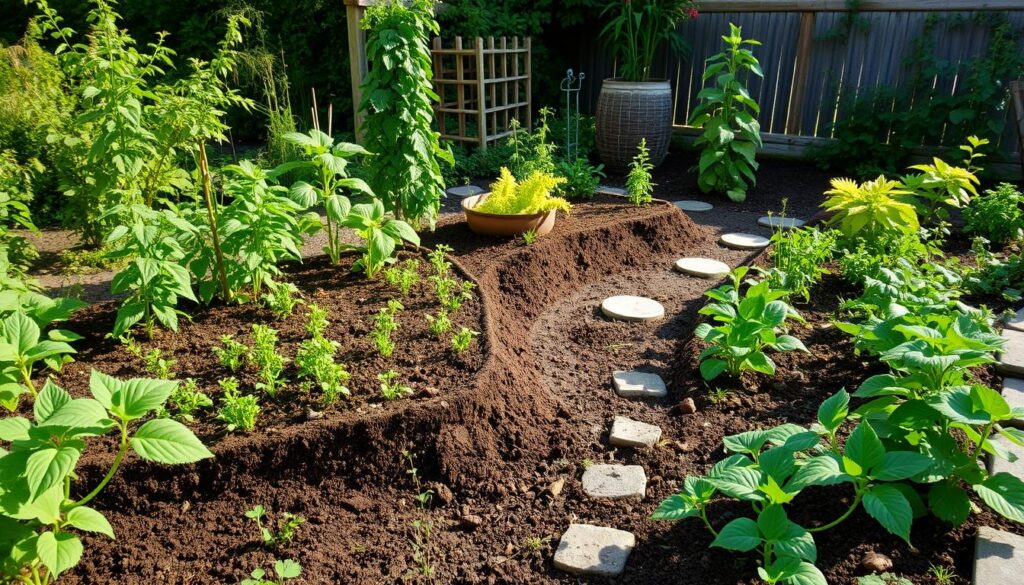
- Reduced soil erosion by up to 80% through mulching
- Improved soil moisture retention by around 30% through composting
- Enhanced soil fertility and structure through cover cropping and crop rotation
Mulching and Composting
Mulching and composting are vital for soil health. They add nutrients, improve structure, and support good microbes. These practices help farmers reduce their environmental footprint and boost soil health.
Agroforestry and Polycultures
Agroforestry and polycultures boost biodiversity and balance ecosystems. They also improve soil health. By using these methods, farmers can enhance soil fertility, cut erosion, and support ecosystem services.
Techniques for Improving Soil Health
Improving soil health is key for sustainable farming. Cover cropping can boost soil nitrogen by 20-30%. Legumes help fix nitrogen. Crop rotation can cut pest numbers by up to 50% compared to growing the same crop over and over.
Integrated pest management is vital for soil health. It combines crop rotation, biological control, and cultural controls to manage pests. This way, farmers can use fewer chemicals and fertilizers. It supports sustainable and regenerative farming.
- Composting can cut solid waste disposal by about 30%
- Organic mulch can keep soil moist by up to 30%
- Natural fertilizers can boost soil microbes by adding more organic matter
By using these methods, farmers can make their soil healthier. They also reduce harm to the environment. This supports sustainable and regenerative farming.
Integrating Permaculture into Farming Practices
Permaculture is a way of farming that focuses on being sustainable and self-sufficient. It uses plants and structures that serve more than one purpose. By using permaculture, farmers can help the environment and make their soil healthier.
Some important steps for using permaculture in farming include:
- Designing a farm that is full of biodiversity and helps ecosystems
- Using methods like mulching and cover cropping to keep soil healthy and capture carbon
- Applying natural farming methods like composting and crop rotation to keep soil fertile without needing outside help
By following these steps, farmers can make their farms more sustainable and strong. As more people want organic gardening techniques and natural farming methods, using permaculture can help farmers stay competitive. It also helps make the food system more sustainable.
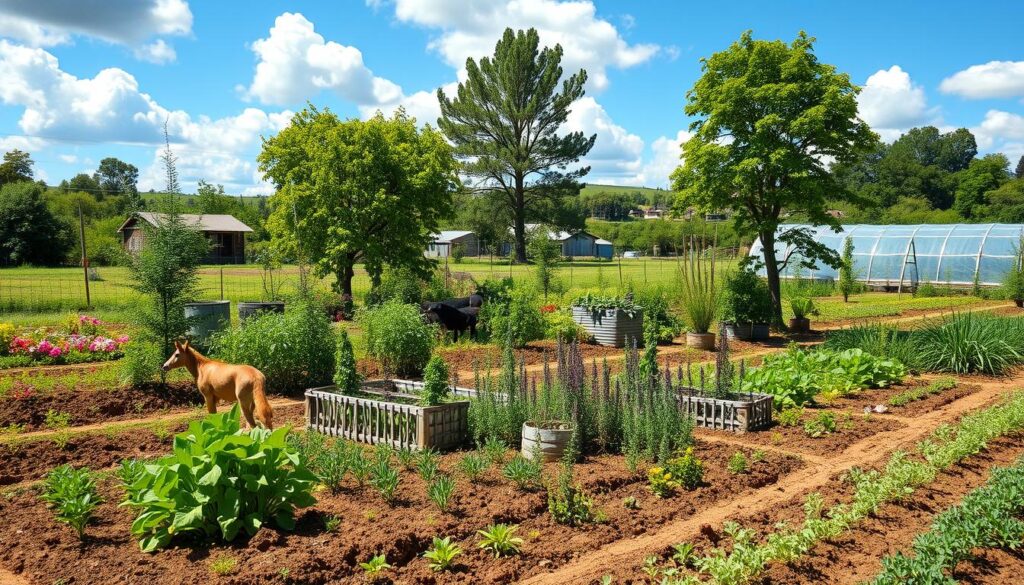
| Strategy | Benefits |
|---|---|
| Regenerative gardening techniques | Reduce soil disturbance, enhance carbon capture |
| Natural farming methods | Maintain soil fertility, reduce need for external inputs |
| Permaculture design | Promote biodiversity, ecosystem services |
Challenges and Limitations of Permaculture
Permaculture aims to create sustainable ecosystems. It faces challenges like climate change affecting soil health. Holistic land management can help by improving soil, biodiversity, and water use.
Some challenges include:
- High initial investment costs
- Labor intensity, mainly in the start
- Complex management due to diverse crops
Despite these, permaculture boosts food security, cuts waste, and supports sustainable ecosystems. For more on its benefits and drawbacks, check out permaculture pros and cons. Using soil fertility restoration and holistic land management can make permaculture thrive.
The table below highlights some key benefits and challenges of permaculture:
| Benefits | Challenges |
|---|---|
| Improved food security | High initial investment costs |
| Reduced waste | Labor intensity |
| Promoted sustainable ecosystems | Management complexity |
Case Studies of Permaculture in Action
Permaculture has been a success in many farms and communities worldwide. It promotes eco-friendly soil practices and sustainable agriculture. Here are some examples of how permaculture works in different places.
Successful Permaculture Farms
Here are some notable permaculture farms:
- Case Study 1: Bangalore Model Farm, which used rainwater and greywater to cut water use by 30% and boost crop yield by 50%.
- Case Study 2: Urban Permaculture Project, which saw a 75% rise in garden productivity. It also educated 200 locals in sustainability.
- Case Study 3: Agroforestry Success, which improved soil organic matter by 20%. It also brought in extra income from timber and fruits.
Community-Based Permaculture Initiatives
Community-based permaculture projects have also shown great results. Here are a few examples:
| Initiative | Location | Outcomes |
|---|---|---|
| Greening the Desert | Jordan | Improved water management through multi-use water systems and increased community participation |
| Village Homes | California, USA | 23 acres of agricultural land and common areas, with 225 homes and a strong focus on community resilience |
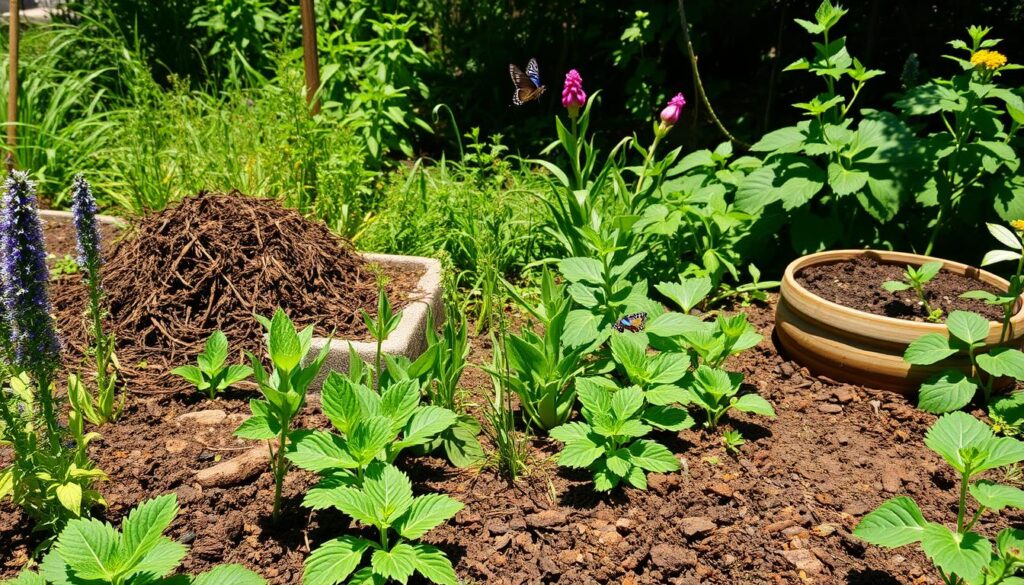
Tools and Technologies for Permaculture
Regenerative farming and organic gardening keep soil healthy and support sustainable farming. Soil testing and analysis are key. They help find nutrient gaps and choose the right fertilizers. Managing water is also vital to save it and cut down on waste.
Drip irrigation systems boost water use by up to 90%. Natural fertilizers like compost and manure boost soil life and plant health. Mulching and cover cropping also help by reducing erosion and improving soil.
Here are some benefits of using regenerative farming and organic gardening:
- Improved soil health and fertility
- Increased crop yields and quality
- Reduced water waste and conservation
- Promotion of biodiversity and ecosystem services
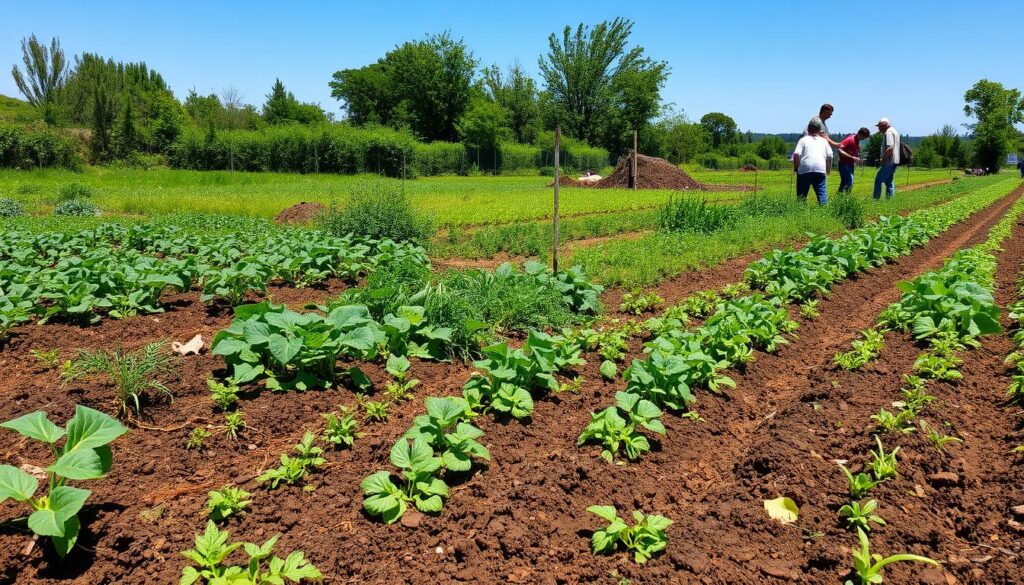
By using these tools and technologies, farmers and gardeners can help the planet. Regenerative farming and organic gardening are key to a healthier food system.
| Technology | Benefits |
|---|---|
| Drip irrigation systems | Increased water efficiency, reduced waste |
| Natural fertilizers | Improved soil microbial activity, promoted healthy plant growth |
| Mulching and cover cropping | Reduced soil erosion, improved soil structure |
Educating and Training in Permaculture
Learning about permaculture is key for a greener future. It teaches us how to care for the earth and build strong ecosystems. Through hands-on training, we learn to improve soil, manage water, and save biodiversity.
Some important parts of permaculture education are:
- Permaculture courses and workshops teach us the basics and beyond.
- Online resources and communities share knowledge and support.
- Practical skills like composting and mulching help our soil.
- Learning natural farming methods like agroforestry boosts biodiversity.
By teaching and training people in permaculture, we help them make a difference. Bill Mollison, permaculture’s co-founder, said, “The only way to make a difference is to start with yourself.” By using permaculture, we can positively impact our ecosystems and the planet.
Future of Permaculture and Soil Health
The future of permaculture and soil health is linked to holistic land management. The world faces challenges like climate change, soil degradation, and biodiversity loss. Permaculture offers a solution by focusing on soil health and using techniques like agroforestry and regenerative agriculture.
Emerging trends and technologies, such as aquaponics and keyline design, are important for permaculture’s future. They help reduce water usage, increase crop yields, and use resources more efficiently. We must innovate and adapt permaculture practices to meet our planet’s changing needs.
Emerging Trends and Technologies
- Aquaponics: a closed-loop system that combines aquaculture and hydroponics to produce food with minimal water usage
- Keyline design: a technique that reduces soil erosion and increases water infiltration, promoting healthier soil and more efficient water use
- Regenerative agriculture: an approach that prioritizes soil health, biodiversity, and ecosystem services to create a more resilient and sustainable food system
Policy and Regulatory Frameworks
To support permaculture and holistic land management, we need policies and regulations. Initiatives like tax breaks for farmers who adopt regenerative agriculture or subsidies for permaculture projects are helpful. By creating a supportive policy environment, we can ensure a future where permaculture and soil health are prioritized, and our planet thrives.
Conclusion
As we wrap up our talk on sustainable mushroom production and packaging, it’s key to highlight the role of eco-friendly soil practices. These practices are vital for keeping soil healthy. By using sustainable agriculture methods, we help the environment and make our food system more sustainable.
Using compost in permaculture boosts soil fertility and structure. This leads to better crop yields and soil health. Healthy soil can increase food production by 20-25% on average, as studies show.
Some main advantages of eco-friendly soil practices and sustainable agriculture are:
- Improved soil fertility and structure
- Increased crop yields and food production potential
- Enhanced soil water retention and reduced irrigation needs
- Increased soil organic carbon stocks and biodiversity
By choosing sustainable agriculture and supporting eco-friendly soil practices, we can build a greener food system. This will ensure a better environment for our children and grandchildren.
| Benefits | Description |
|---|---|
| Improved soil fertility | Enhanced soil structure and increased crop yields |
| Increased food production | Improved agricultural yields and reduced food waste |
| Reduced irrigation needs | Enhanced soil water retention and reduced water consumption |
References
If you’re curious about permaculture and soil health, there’s a lot to learn. Here’s a list to get you started on regenerative farming practices and organic gardening techniques.
List of Sources
- National Institute of Food and Agriculture
- United States Department of Agriculture
- Permaculture Research Institute
Further Reading
Looking for more on permaculture and soil health? Check out the Journal of Sustainable Agriculture and the Permaculture Magazine. They’re packed with info on regenerative farming practices and organic gardening techniques. They’re great for anyone wanting to boost soil health and support sustainable farming.
Final Thoughts
Permaculture plays a key role in keeping our soil healthy. It offers a sustainable way to farm. By using methods like composting and cover cropping, we can make our soil better.
These methods help us grow food in even the smallest spaces. They turn urban areas and lawns into places that feed both plants and people.
But, we face challenges like climate change. Permaculture’s principles help us build strong ecosystems. By teaching others, supporting research, and pushing for policy changes, we can make a big difference.
We can use soil building strategies and natural farming methods to improve our land. This will help us have a better future with more food for everyone.

